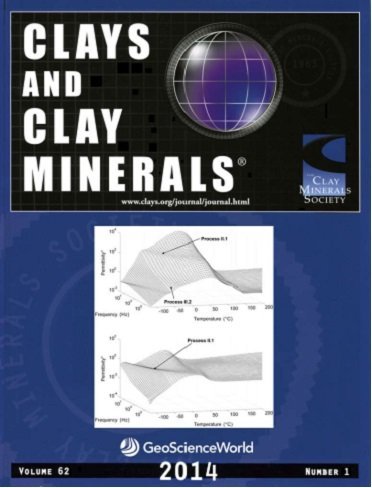The article “Dielectric Relaxation of Water in Clay Minerals” of KFU researches of the Dielectric Spectroscopy Laboratory was published in “Clays and Clay Minerals” journal.
The journal editor found the issue of dielectric relaxation of water in clay minerals interesting enough to enter the little number of articles that worth the attention of world physicists of all scientific sectors. Therefore he put the results of the research on the dielectric properties of aluminosilicates received in KFU Institute of Physics on the cover of Clays and Clay Minerals.
 Clays and Clay Minerals is the official publication of the Clay Minerals Society. The journal publishes articles of interest to the international community of clay scientists, including but not limited to areas in mineralogy, crystallography, geology, geochemistry, sedimentology, soil science, agronomy, physical chemistry, colloid chemistry, ceramics, petroleum engineering, foundry engineering, and soil mechanics. Clays and Clay Minerals exists to disseminate to its worldwide readership the most recent developments in all of these aspects of clay materials. Manuscripts are welcome from all countries.
Clays and Clay Minerals is the official publication of the Clay Minerals Society. The journal publishes articles of interest to the international community of clay scientists, including but not limited to areas in mineralogy, crystallography, geology, geochemistry, sedimentology, soil science, agronomy, physical chemistry, colloid chemistry, ceramics, petroleum engineering, foundry engineering, and soil mechanics. Clays and Clay Minerals exists to disseminate to its worldwide readership the most recent developments in all of these aspects of clay materials. Manuscripts are welcome from all countries.
The article is a part of the joint project of two dielectric spectroscopy laboratories – of the Kazan Federal University and the Hebrew University of Jerusalem.
The writing team included the staff of the Department of Radioelectronics of Kazan Federal University – Maria Vasilyeva, assistant; Yuri Gusev, Head of Dielectric Spectroscopy of Complex Systems Laboratory; Valery Shtyrlin, member of the Department of Non-organic Chemistry of the Butlerov Institute if Chemistry; and the experts of the Hebrew University of Jerusalem - Dr. Anna Greenbaum Gutina; Prof. Alexander Puzenko; Dr. Paul Ben Ishai, and Prof. Yuri Feldman.
Article abstract
The study of confined water dynamics in clay minerals is a very important topic in aluminosilicate-surface chemistry. Aluminosilicates are among the most technologically versatile materials in industry today. Dielectric spectroscopy is a very useful method for investigating the structure and dynamics of water adsorbed on solid matrix surfaces and water in the vicinity of ions in solutions. Use of this method for the study of clay minerals has been underutilized to date, however. The main goal of the present research was to understand the relaxation mechanisms of water molecules interacting with different hydration centers in clay minerals, with a view to eventually control this interaction. Two types of natural layered aluminosilicates (clay minerals) – montmorillonite with exchangeable K+, Co2+, and Ni2+ cations and kaolinite with exchangeable K+ and Ba2+ cations – were examined by means of dielectric spectroscopy over wide ranges of temperature (from − 121?C to +300?C) and frequency (1 Hz–1 MHz). An analysis of the experimental data is provided in terms of four distributed relaxation processes. The low-temperature relaxation was observed only in montmorillonites and could be subdivided into two processes, each related to a specific hydration center. The cooperative behavior of water at the interface was observed in the intermediate temperature region, together with a proton percolation. The dielectric properties of icelike and confined water structures in the layered clay minerals were compared with the dielectric response observed in porous glasses. The spatial fractal dimensions of the porous aluminosilicates were calculated by two separate methods – from an analysis of the fractality found in photomicrographs and from the dielectric response.